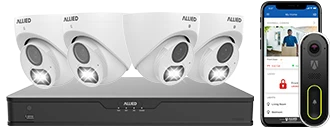Introduction to Security System Monitoring
The increasing importance of security system monitoring is evident in today’s interconnected world. As we continue to rely on technological advancements, safeguarding both personal and commercial environments becomes crucial. Security system monitoring provides real-time surveillance and alerts that significantly contribute to reducing risks and enhancing safety.
Security systems are designed to detect, deter, and respond to various threats such as burglaries, fires, or unauthorized access. Monitoring these systems ensures that any potential threats are identified and addressed promptly. This real-time surveillance capability is a cornerstone in protecting assets and ensuring the safety of individuals.
One of the primary reasons for employing security system monitoring is the immediate response it facilitates. For example, when a monitored alarm is triggered, the monitoring center can instantly contact emergency services, thus significantly reducing response times. Without monitoring, valuable time could be lost during an emergency, leading to potentially severe consequences.
Additionally, the presence of a monitored security system serves as a deterrent to potential criminals. Statistics from various law enforcement agencies indicate a correlation between the presence of surveillance systems and reduced crime rates. The visibility of surveillance cameras and warning signs indicating active monitoring can dissuade criminals from attempting illegal activities.
Monitoring systems also provide critical data that can be analyzed to improve security measures. This data can include the frequency and types of alerts, times and locations of incidents, and the effectiveness of responses. By reviewing this information, organizations can refine their security protocols, thereby enhancing their overall approach to safety.
Another essential aspect is the seamless integration of modern security systems with other technologies. For example, many systems now incorporate smart home devices, allowing users to monitor their property remotely via smartphones or tablets. This integration not only provides convenience but also enhances the level of oversight and control users have over their security measures.
The table below highlights the key benefits provided by security system monitoring:
| Benefit | Description |
|---|---|
| Immediate Response | Quickly contacts emergency services, reducing response times. |
| Crime Deterrence | Visible surveillance reduces the likelihood of criminal activity. |
| Critical Data Collection | Allows analysis of incident data to improve security measures. |
| Technological Integration | Enables remote monitoring and control through smart devices. |
In conclusion, security system monitoring plays a vital role in enhancing safety and security in various settings. By providing immediate response capabilities, deterring crime, collecting essential data, and facilitating technological integration, it ensures that individuals and organizations can protect their assets and maintain a secure environment.
Historical Overview of Security Monitoring Technologies
The history of security monitoring technologies dates back several centuries, with significant advancements over time that have shaped the sophisticated systems we rely on today.
Early Security Measures
Before electronic systems, physical security measures such as locks, guards, and watchdogs were the primary methods of safeguarding property and individuals. While effective to a degree, these methods were limited by human and mechanical constraints.
The Advent of Electronic Security
The development of electronic security systems began in the late 19th century. One of the earliest instances was the invention of the burglar alarm by Edwin Holmes, who commercialized the device in the 1850s. Holmes’ alarm system was a basic circuit that would trigger an alert if a door or window was opened.
In the mid-20th century, advancements in telecommunications and electronics led to more sophisticated alarm systems. The introduction of closed-circuit television (CCTV) in the 1940s marked a significant milestone, allowing surveillance through video feeds. The first CCTV system was installed in Germany in 1942 for observing rocket launches, and its use soon expanded to security applications.
Integration with Digital Technologies
The 1970s and 1980s saw the integration of microprocessors into security systems. This innovation enabled more complex functionalities such as motion detectors, intruder alarms that could be set and unset remotely, and systems that could store video footage, making it easier to review incidents after they occurred.
By the late 1990s, the rise of digital technology brought about Internet Protocol (IP) cameras, which could transmit data over the internet, allowing remote access and monitoring from anywhere in the world. This period also saw the emergence of centralized monitoring stations capable of supervising multiple sites simultaneously.
Modern Developments
In recent years, security monitoring has been revolutionized by advancements in artificial intelligence (AI) and machine learning. Modern systems are equipped with capabilities such as facial recognition, anomaly detection, and real-time analytics. These technologies allow for proactive security measures, such as predicting potential security breaches and automating responses to threats.
The integration of smart devices and the Internet of Things (IoT) has further enhanced security monitoring. Devices such as smart locks, sensors, and cameras can now communicate with each other, providing a comprehensive security ecosystem that is coordinated, scalable, and responsive.
- Artificial Intelligence (AI): Enables systems to learn from data, recognize patterns, and make decisions, facilitating automated threat detection and response.
- Internet of Things (IoT): Connects various security devices and enables them to work in unison, enhancing overall efficacy.
- Cloud Technology: Allows for the storage and retrieval of vast amounts of security data, which can be accessed and analyzed in real-time from anywhere.
Overall, the evolution of security monitoring technologies has been driven by the need for more effective and efficient ways to protect people and property. From simple mechanical solutions to sophisticated digital systems, the journey of security monitoring continues to evolve, promising even more advanced and integrated solutions in the future.
Types of Security Systems and Their Monitoring Techniques
Security systems encompass a variety of technologies, each tailored to specific security needs. Effective monitoring of these systems ensures they function correctly and alert the necessary stakeholders in the event of a security breach. Below are some common types of security systems and their corresponding monitoring techniques.
Burglar Alarms: Burglar alarms are designed to detect unauthorized entry into a building or area. These systems are typically monitored through:
- Central Monitoring Stations: When the alarm is triggered, a signal is sent to a central monitoring station, where operators can quickly notify local authorities.
- Self-Monitoring: Some systems allow users to monitor real-time alerts on their smartphones or computers through dedicated apps or software.
Fire and Smoke Alarms: Fire detection systems play a crucial role in safeguarding lives and property. Monitoring techniques include:
- Connected Smoke Detectors: These devices communicate with central monitoring stations to report incidents, ensuring rapid emergency service response.
- Networked Systems: Advanced systems connect smoke detectors within a network, enabling quick identification of the fire’s location within a building.
Surveillance Cameras: Surveillance systems monitor and record activities to prevent and investigate incidents. They can be monitored using:
- Live Video Monitoring: Security personnel view live feeds to identify suspicious activities. This can be done on-site or remotely through internet-connected devices.
- Video Analytics: Employing AI-driven software to analyze video footage in real-time, detecting unusual patterns, motion, or behaviors.
Access Control Systems: These systems regulate who can enter or exit specific areas. Monitoring methods include:
- Real-Time Alerts: Alerts are sent to security personnel when unauthorized access attempts are detected.
- Audit Logs: Comprehensive logs of access attempts are maintained, enabling post-event analysis and investigations.
Environmental Monitoring Systems: These systems monitor environmental conditions such as temperature, humidity, and smoke. Common monitoring methods are:
- Sensor Networks: Sensors distributed throughout a facility report data to a central system, which can trigger alerts if conditions deviate from preset parameters.
- Remote Monitoring: Data from environmental sensors can be accessed remotely, allowing for constant oversight without physical presence.
In conclusion, various types of security systems encompass a wide array of monitoring techniques aimed at ensuring continuous protection and rapid response to potential threats. The blend of real-time alerts, central monitoring, and advanced technologies enable these systems to maintain high security standards efficiently.
Key Benefits of Security System Monitoring
Security system monitoring plays a crucial role in safeguarding both residential and commercial properties. One of the primary benefits is the provision of 24/7 surveillance. Continuous monitoring ensures that any suspicious activity can be promptly identified and addressed, helping to prevent potential security breaches.
Another significant benefit is real-time response. Monitored systems can alert law enforcement or security personnel the moment a threat is detected. This immediate communication is vital in minimizing damage and enhancing the chances of apprehending perpetrators.
Remote accessibility is also a key advantage. Modern security systems often offer mobile applications that allow property owners to monitor their premises from any location. This feature provides peace of mind and greater control over security measures, even when one is away.
Monitoring systems can effectively reduce false alarms. Advanced technologies and professional monitoring services are adept at discerning between actual threats and false alarms due to non-threatening factors, such as pets or weather conditions. This distinction is crucial in ensuring that response resources are not unnecessarily deployed.
In addition, evidence collection is greatly facilitated by security system monitoring. Recorded footage from monitoring systems can serve as vital evidence in criminal investigations and legal proceedings, providing indisputable records of events as they occurred.
Insurance benefits are also notable. Many insurance companies offer reduced premiums for properties equipped with monitored security systems. This reduction reflects the decreased risk of theft, vandalism, and other damages, representing a financial advantage for property owners.
Furthermore, security system monitoring contributes to overall safety and peace of mind. Knowing that a property is continuously monitored allows inhabitants and employees to feel secure, promoting a sense of well-being and productivity.
Through these benefits, it is evident that security system monitoring is an essential component in modern security strategies, providing comprehensive protection and numerous advantages for property owners.
Real-World Impact: Crime Prevention and Response
Properly implemented security system monitoring has a significant real-world impact in both the prevention of crimes and the effectiveness of response efforts. Several studies and statistics underscore the tangible benefits and outcomes associated with robust security monitoring.
Crime Deterrence
One of the primary advantages of security system monitoring is its deterrent effect on criminal activity. According to a study published by the Urban Institute, the installation of monitored surveillance cameras in public places reduced crime by an average of 23%. The visibility of cameras and the knowledge that areas are under continuous watch dissuades potential offenders.
Reduction in Response Times
Monitored security systems enable faster response times from law enforcement agencies. Real-time alerts provided by these systems ensure that police and emergency services can be dispatched immediately when an incident occurs. For instance, statistics from the International Association of Chiefs of Police indicate that monitored alarms reduce police response times by approximately 50% compared to unmonitored systems.
Evidence Collection and Prosecution
The role of security system monitoring extends beyond immediate prevention and response. Continuous monitoring aids in evidence collection, which can be crucial during prosecution. High-definition video recordings and real-time data logs provide law enforcement with clear, indisputable evidence that can be used in court. Data from the Bureau of Justice Statistics suggests that cases with high-quality video evidence have higher conviction rates.
Case Examples and Statistical Impact
Data from various sources demonstrate real-world impacts in different sectors:
- Retail Sector: The National Retail Federation reports a 60% reduction in theft incidents in stores equipped with monitored surveillance systems.
- Residential Areas: Neighborhoods with a high density of monitored home security systems have seen burglary rates drop by up to 50%, according to a study by the Journal of Quantitative Criminology.
- Public Transit Systems: Studies conducted by Transport for London show a 34% decrease in crime rates on transit systems with comprehensive camera surveillance and monitoring.
Community and Psychological Benefits
Apart from tangible crime statistics, security system monitoring contributes to an overall sense of safety and well-being within communities. The presence of monitoring systems increases public confidence and trust in local security measures. Research by the European Journal of Criminology highlights that visible surveillance can significantly improve the perceived safety among residents and deter anti-social behavior.
In conclusion, the real-world impact of security system monitoring is profound and multifaceted. From deterring crime and reducing response times to aiding in evidence collection and fostering community well-being, the benefits are extensive and well-documented through various studies and statistics. This makes the case for widespread implementation of monitored security systems in both public and private sectors.
Technological Advancements in Security Monitoring
Technological advancements in security monitoring have revolutionized the way modern security systems operate, enabling more robust and responsive security measures. The evolution of these technologies continues to enhance the effectiveness and efficiency of security systems across various domains. This chapter explores some of the critical technological innovations that are transforming security system monitoring.
1. Internet of Things (IoT):
The integration of IoT has significantly improved security system monitoring by enabling interconnected devices to communicate and share data in real-time. IoT-enabled security systems provide seamless connectivity between sensors, cameras, alarms, and control centers, ensuring prompt and coordinated responses to potential threats.
- Real-Time Alerts: IoT devices can detect security breaches instantly and alert authorized personnel through mobile devices or control centers.
- Remote Monitoring: Users can monitor security systems from anywhere, providing flexibility and ensuring continuous surveillance even when offsite.
2. Artificial Intelligence (AI) and Machine Learning (ML):
AI and ML technologies have empowered security systems to analyze vast amounts of data quickly and accurately. These technologies enhance the predictive and analytical capabilities of security systems, leading to more effective monitoring and incident management.
- Pattern Recognition: AI algorithms can identify unusual patterns of behavior and predict potential security threats before they occur.
- Automated Decision Making: ML models enable systems to take predefined actions in response to specific triggers, such as locking doors or sounding alarms.
3. Advanced Camera Technologies:
Improvements in camera technology have greatly increased the quality and scope of surveillance. High-definition (HD) cameras, thermal imaging, and panoramic cameras provide detailed and comprehensive monitoring capabilities.
- High-Resolution Imaging: HD cameras capture clear and detailed visuals, aiding in the accurate identification of individuals and incidents.
- Thermal Imaging: Thermal cameras detect heat signatures, allowing visibility even in complete darkness or through smoke and fog.
- Panoramic Viewing: Multi-lens and 360-degree cameras offer extensive field-of-view coverage, reducing blind spots.
4. Cloud-Based Services:
Cloud computing has revolutionized data storage and accessibility for security systems. Cloud-based monitoring solutions provide scalable storage options and facilitate the effective management of large volumes of data.
- Scalability: Cloud services can be easily scaled up or down based on the requirements of the security system.
- Data Accessibility: Authorized users can access surveillance data and footage from any location with internet connectivity.
5. Cybersecurity Measures:
As security systems become more interconnected, ensuring the cybersecurity of these systems has become paramount. Advanced encryption techniques and secure communication protocols are essential to protect data from cyber threats.
- Encryption: Encrypting data transmitted between devices and control centers prevents unauthorized access and tampering.
- Authentication: Multi-factor authentication methods enhance the security of user access to monitoring systems.
Technological advancements continue to play a pivotal role in the evolution of security system monitoring. Leveraging modern technologies not only enhances the capabilities of security systems but also ensures a proactive approach to safeguarding assets and individuals.
Future Trends and Challenges in Security System Monitoring
The future of security system monitoring is poised to be shaped by both evolving technologies and emerging challenges. These factors together will redefine how security systems function and how effective they are in mitigating threats.
One significant trend is the increased use of Artificial Intelligence (AI) and machine learning. These technologies can analyze vast amounts of data in real-time, identifying patterns and anomalies that may signify security threats. AI-driven systems can improve threat detection accuracy and reduce the number of false alarms.
Another key trend is the integration of Internet of Things (IoT) devices. IoT-enabled security systems can connect various components like cameras, sensors, and alarms, providing a comprehensive and interconnected security solution. This connectivity allows for more synchronized responses to potential threats.
Cybersecurity considerations are also becoming more critical. As more systems become internet-connected, they are vulnerable to cyber-attacks. Therefore, future security systems will require robust cybersecurity measures to protect against hacking and data breaches.
The following table highlights some of the upcoming trends and their associated challenges:
| Trend | Challenges |
|---|---|
| AI and Machine Learning | Data privacy concerns, need for large datasets to train algorithms |
| IoT Integration | Interoperability issues, increased points of vulnerability |
| Enhanced Cybersecurity | Complexity of protecting interconnected systems, evolving cyber threats |
Additionally, the role of cloud computing in security system monitoring is expanding. Cloud-based systems offer scalable storage solutions and easier data access for remote monitoring. However, cloud security and data privacy remain significant concerns that need to be addressed.
The increasing deployment of biometric systems for authentication is another notable trend. Biometric technologies such as fingerprint scanners, facial recognition, and retinal scans enhance security by making it harder for unauthorized individuals to gain access. Yet, issues regarding biometric data storage and potential misuse need to be managed.
As these trends take shape, the security industry will also have to address regulatory and ethical concerns, ensuring that advancements in technology do not compromise individual privacy and civil liberties.













